Petrodollar Recycling And Global Imbalances -- Presentation by Saleh M. Nsouli, Director, Offices in Europe, International Monetary Fund
March 23, 2006
Director, Offices in Europe
International Monetary Fund
At the CESifo's International Spring Conference
Berlin, March 23-24, 2006
I. Introduction
The surge in oil prices in recent years has been taking place in an environment of rising global imbalances. Starting around 1996, a large current account deficit in the United States has been matched by surpluses primarily in other advanced economies and in emerging Asia, and has been accompanied by corresponding shifts in net foreign asset positions. To promote adjustment, policy advice has focused mainly on the need to promote savings in the United States and to foster expenditure in Asia, while moving to more flexible exchange rates arrangements. The impact of these recommendations has been limited so far, and large imbalances persist.
The doubling of oil prices during 2002-05 has made the group of oil-exporting countries a major player on the global current account imbalances scene. The increase in oil prices has shifted large additional sums of money from oil-consuming to oil-producing countries. How oil exporters "recycle" this revenue becomes a crucial issue, not only in determining the economic development of their countries in the future, but also in affecting the orderly narrowing of the global imbalances.
This paper examines the issues at stake when considering the global impact of petrodollar recycling. It addresses four questions:
- What is the best definition of "recycling" in this context?
- What is the order of magnitude of the oil shock in the current context?
- What is the impact of the recent rise in oil prices on the global imbalances?
- What are the policy recommendations for oil-exporting countries, particularly with a view to contributing to the orderly reduction of the global imbalances?
II. What is "Recycling"?
Petrodollar "recycling" refers to the reflows to the rest of the world that result from the use oil-exporting countries make of their oil receipts. A portion may be spent to purchase foreign goods and services, and another saved in foreign assets held abroad. Such foreign assets may range from deposits held in foreign banks to bonds and private equity.
One way or another, all of the foreign exchange that flows to oil exporters as a result of an increase in oil exports flows back—or is "recycled"—to the rest of the world. It is useful to distinguish the two channels through which recycling takes place:
• One may be called the absorption channel: petrodollars are spent to finance domestic consumption and investment, thus increasing the demand for imports of goods and services.
• Another is the capital account channel: petrodollars not spent on imports are saved in foreign assets held abroad, resulting in a capital account outflow. These assets are held by central banks as part of their international reserves or by institutional funds of oil-exporting countries. They can be held in foreign financial instruments, including a variety of currencies. During the previous high oil prices episodes, oil exporters also loaned part of their official reserves to the IMF to finance the balance of payment needs of a number of non-oil exporting countries resulting from the increase in oil prices, thus being "recycled" through the IMF.
The literature often focuses on the capital account channel when referring to "recycling." However, both channels are of importance when assessing the impact of the increase in oil revenues on global imbalances. The absorption channel plays a significant role in narrowing imbalances, and it is thus important to take it into account. Indeed, oil exporters' imports may come partly to offset the initial oil price-driven revenue inflow in their current account. If those imports come from oil-importing countries, they also help reduce the pressure on oil importers' current accounts. Furthermore, depending on their destination, oil exporters' capital outflows may play to ease liquidity conditions in oil-importing countries. Therefore, in considering the impact of the latest oil price shock on global imbalances, and the policy recommendations for the governments of oil-exporting countries, the term "recycling" in this note refers to all forms taken by the reflows of petrodollars to the rest of the world.
III. How Big is the Increase in Oil Receipts?
Energy prices have risen sharply since 2002. They reached an average US$53 per barrel in 2005, more than twice their level just 3 years before.2 This increase has been driven by strengthening global demand and, most recently, by concerns about future supply. With limited excess capacity, the medium-term supply-demand balance is expected to remain very tight, and oil prices to persist well above previously expected levels. In real terms, however, oil prices remain still significantly below their value in the late 1970s and early 1980s (Chart 1).
| Chart 1 Real Oil Prices (in constant 2005 U.S. dollars per barrel) |
|---|
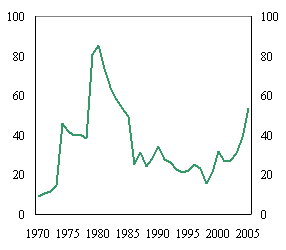 |
As a result of the rise in oil prices, and to a lesser extent of rising production as well, the oil export revenue of the major oil-exporting regions of the world has more than doubled in a short span of time.3 For the group of oil-exporting countries, oil export revenue has risen from US$262 billion in 2002 to an estimated US$614 billion in 2005. This increase of US$352 billion corresponds to an extra 40 percent of pre-boom GDP for oil exporters. This increase, nonetheless, represents a small fraction of world GDP, below that observed in previous high oil price episodes (Table 1).
| Table 1. Increase in Oil Exporters’ Oil Export Revenue1 | ||
|---|---|---|
| Percent of own GDP | Percent of World GDP | |
| 1973-76 | 48 | 1.5 |
| 1978-81 | 31 | 1.4 |
| 2002-05 | 40 | 1.0 |
| Source: IMF World Economic Outlook. 1Ratios are relative to GDP in the first year of each period. They exclude Kazakhstan for which oil data are unavailable for all periods. |
||
The oil exporters' current account surplus was small compared to the magnitude of the global imbalances in 2002, but its scale has been growing rapidly. As a result of the recent rise in oil prices, oil exporters have become important counterparts to the United States in the ownership of foreign savings. Their current account surplus represented in 2005 some 40 percent of the U.S. current account deficit, nearly doubling in one year (Chart 2).
| Chart 2 Current Account Positions (in billions of US$) |
|---|
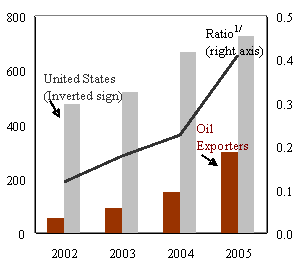 |
| 1Ratio of current account of oil exporters to current account of the United States (in percent, right axis). |
Oil exporters are close to becoming more important than Asia in the holding of net savings outside the United States (Chart 3). While Asia's current account surplus is projected to have risen to US$341 billion in 2005 (equivalent to 47 percent of the United States' current account deficit), that of oil exporters is projected to have reached US$296 billion (equivalent to 41 percent of the United States' current account deficit). Relative positions are expected to reverse in 2006. According to IMF projections, oil exporters' current account surplus would amount to 46 percent of the U.S. deficit in 2006, while the figure for Asia would drop to 41 percent.
| Chart 3 Foreign Savings (Current account surplus, US$ billion) |
|---|
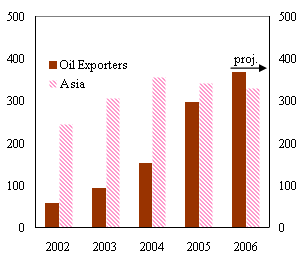 |
While any long-run oil price forecast is subject to uncertainty, an assessment of oil futures markets suggests that a considerable proportion of the recent shock should be permanent in nature. Assuming that two thirds of the oil price increase proves permanent in nature, in line with the IMF's April 2005 WEO scenario, the rise in value of oil exporters' petroleum reserves since 1999 would imply a US$850 billion increase in their permanent income, almost three times the observed increase in their total imports since 1999.4 Such a rise in oil wealth offers a great opportunity for oil exporters to address domestic economic needs. It also presents all "actors" with the formidable challenge to address the new "play" of global imbalances.
IV. What is The Impact on Global Imbalances?
Oil exporters have not been the main "actors" affecting the United States' large and growing current account deficit. Growing net imports from Asia, and in particular China, have played the most significant role in explaining the overall expansion of the U.S. trade deficit, which has risen from some 2 percent of GDP in 1996 to over 7 percent in 2005 (Chart 4).
| Chart 4 United States’ Bilateral Trade Deficit (in percent of U.S. GDP) |
|---|
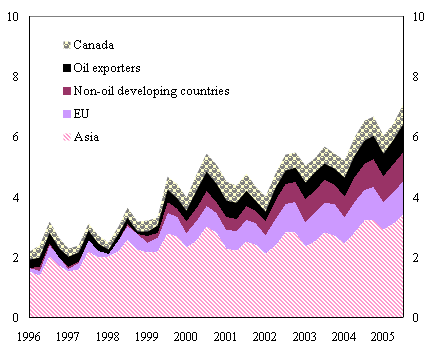 |
In addition, the rise in oil prices has so far not helped much to reduce current account imbalances between the United States and Asia. Even though it has been running a rising deficit in its oil trade accounts, Asia has not been dissaving as a consequence. In fact, Asia's current account has strengthened since 2002. By contrast, the United States' current account deficit has continued to widen, with the group of oil-exporting countries becoming an increasingly significant counterpart in the allocation of world current account imbalances (Chart 5).
However, whether oil exporters spend or save their oil revenue has major implications for the future dynamics of current global imbalances. In theory, the adjustment process resulting from such decisions would be as follows:
• If energy exporters spend their oil revenue, part of the petrodollar inflows would flow out again to pay for imports of goods and services, some of them possibly from the industrialized oil-importing countries from which the petrodollars came. This would play to reduce—or limit the increase in—the global imbalances.
• If, on the other hand, oil exporters save their revenue, it may in a first round drain financial resources away from investment or consumption in the oil-importing world, reducing their growth and employment prospects.
• However, the oil-exporting countries would mitigate this impact to the extent that they place their petrodollars in any assets that result in a reflow of U.S. dollars into the United States, thus limiting the impact on interest rates of the initial outflow of funds resulting from increased oil prices.
| Chart 5 Oil trade and global imbalances (in billion of U.S. dollars) |
|---|
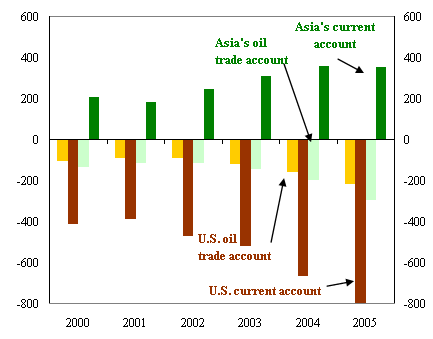 |
What are oil exporters doing with the extra oil revenue? Given the large government share in the oil sector in most oil-exporting countries, and thus in oil revenue, the deployment of the additional oil income is mainly the decision of governments. In many cases, in particular in the Middle East and Africa, these have adopted conservative assumptions on the path of oil prices in their budgets, much below market prices, and little of the excess revenue from oil exports is estimated to have been spent.
Indeed, many governments have been spending their oil revenue carefully. Newspapers have reported on a few cases of extravagant spending. But a number of countries have been prudent, deciding to invest in social and infrastructure projects, and in housing and education, as well as to repay foreign debt.
So far, the portion of oil exporters' revenue that has been spent has not played an important role in reducing the United States' current account deficit. Oil exporters show a much lower tendency to import from the United States than either developed economies or developing countries (Table 2). In fact, oil exporters have turned into large buyers of goods from Asia, a region where they also sell the bulk of their oil. This has mitigated the improvement in the trade surplus of oil-exporting countries vis-à-vis Asian countries, which has been much less marked than the rise in oil exporters' trade surplus vis-à-vis the United States (Chart 6).
| Table 2. Imports from the United States, 2004 (in percent of group’s total imports) | ||
|---|---|---|
| Fuel exporters | 8.4 |
|
Advanced economies |
25.8 |
|
Other developing countries |
19.5 |
|
Source: IMF Direction of Trade Statistics. |
||
| Chart 6 Oil exporters' trade balance (in percent of oil exporters' GDP) |
|---|
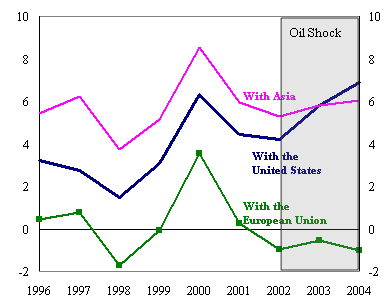 |
History suggests that it takes time for oil exporters to adjust spending to higher oil revenue. In the past high oil price episodes, oil exporters' imports continued to rise years after oil prices had stopped increasing and even had started to decline (Chart 7). The lag in adjusting expenditures observed in the past can be interpreted as a sign that oil exporters assumed a higher permanent component in the price hikes than turned out to be the case ex post, and then found it difficult to curtail spending when it became evident that the assumption of high oil prices was not well-founded. It remains to be seen whether the low spending today reflects well-learnt lessons from the past, or the time it takes to devise and implement large spending plans. A key question is thus whether oil exporters see the currently high level of oil prices as temporary or permanent.
| Chart 7 Imports and Oil Receipts |
|---|
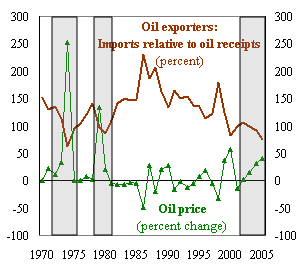 |
In the aggregate, simple calculations show that a large part of the increase in oil revenue has been saved. Between 2002 and 2005, of the US$352 billion increase in oil export receipts, only about 52 percent was spent on additional imports of goods and services. This is less than during the two previous oil shocks (1974-76 and 1979-81), where an average of 90 percent of the additional oil export receipts was spent on imports.
There is a certain amount of debate about this historical comparison, however, because of its sensitivity to the time periods used and the definition of spending of oil revenues. In 2004, for example, oil exporters' annual imports represented 91 percent of that year's oil revenue, about the same as in previous periods. This shows that imports do absorb a large chunk of oil export revenue—even though they are not growing as fast. But the recent record underscores that oil exporters have not spent the extra revenue as fast as they did in the past.
It is, however, unclear in which region, currency, or assets oil revenue savings are held. Central bank reserves in oil-exporting countries have increased some US$90 billion in 2005, but this accounts for less than a third of their combined current account surplus (Chart 8). In some countries, like Russia, Saudi Arabia, and U.A.E., governments have given their oil revenue surplus to newly-created, sophisticated investment agencies or oil stabilization funds to manage. These are subject to less stringent reporting requirements than central banks, and their investments have been hard to track. There has also been relatively little accumulation of petrodollars in bank deposits, in contrast to the experience in the 1970s. Fuel-exporting countries' deposits in BIS-reporting banks amount to less than a third of their cumulative current account surpluses. As noted by the BIS in its December 2005 report, a large proportion of petrodollars cannot be accounted for on the basis of counterparty data.
| Chart 8 Change in International Reserves (in US$ billion) |
|---|
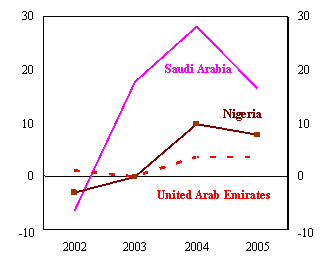 |
It is also true that oil exporters face much broader investment opportunities for their savings today than in the 1970s and 1980s. Local stock markets have developed tremendously and have now the capacity to absorb large oil-related inflows. Returns on the Russian and Middle Eastern stock markets, for example, skyrocketed in the past year. The real estate boom taking place in the Middle East provides additional new opportunities for local equity participation. To the extent that government petrodollars have to be converted into domestic currency for local investment purposes the dollars will end up in the central bank without directly affecting current account imbalances. However, the wealth effect of the rise in the value of local assets is likely to work through the absorption channel to stimulate imports.
But as evidenced by the small increase in oil exporters' official reserves relative to their current account surpluses, a large share of the oil revenue is being held as investment abroad. There is anecdotal evidence that local government-owned companies have taken large stakes in private equity abroad. Dubai's stake in Daimler, in the Tussaud Group in the UK, and, most recently, in P&O, Britain's largest port and ferries group, have been well reported in the press. U.S. Treasury data would support the view that OPEC is diversifying away from U.S. government bonds: the data indicates that OPEC's holdings of U.S. Treasury bonds have fallen during 2005. But it is also possible that, to avoid new Patriot Act-related disclosure requirements, such investments are being booked through intermediaries based in London, Geneva, and Hong Kong, or offshore financial centers, which are subject to varying regulations, and are difficult to track.
There are reasons for U.S. assets to remain an important component of oil exporters' savings allocation. The Gulf Cooperation Council (GCC) countries have been pegged to the dollar since 2003, and Russia operates a managed float of the ruble vis-à-vis a highly dollar-weighted basket of currencies. The majority of oil exporters' central bank reserves remains invested in the dollar. And oil sales are still priced, invoiced, and settled in dollars. It is thus likely that purchases of U.S. securities will continue to take place, even though not necessarily through the traditional channels.
All in all, the rise in oil prices contributed to driving up the current account deficit of regions already in deficit, but petrodollar recycling has mitigated the impact on those countries. Oil exporters' preference for investing their petrodollars in the United States has alleviated pressures on the cost of funds from high oil price-driven outflows of dollars (Chart 9). This may have kept U.S. long-term interest rates low, even as the U.S Federal Reserve has hiked its short-term rate to rein in inflation. This may have contributed to bolstering consumer spending and growth in the United States, softening the impact of higher oil prices on the industrialized world as a whole. According to latest IMF projections, more expensive energy will have only a modest impact on global growth, which, owing to various factors, should drop to 4.8 percent in 2006, from 5.1 percent in 2005.
| Chart 9 U.S. Yield Curve (in percent) |
|---|
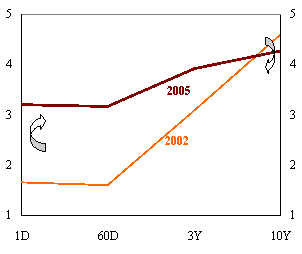 |
In the medium term, however, risks of a disorderly adjustment of global imbalances remain, for two main reasons.
• High oil prices have made the United States dependent on what may be a volatile source of savings. The agencies managing oil exporters' savings may follow more opportunistic, profit-driven investment strategies than central banks need to do with their reserves. They may switch part of their investments away from dollar assets faster if interest differentials become less favorable or if they fear capital losses from potential exchange rate movements.
• The gradual increase in spending in oil-exporting countries could cause long-term U.S. interest rates to rise. Over time, oil exporters' spending will rise as governments revise up oil price assumptions in their budgets and their current account surpluses fall, assuming oil prices stabilize. If such spending shifts large sums of money back to countries with a lower propensity to save than oil exporters, the resulting rise in the cost of funds may adversely affect borrowing countries like the United States. This, of course, depends on where oil exporters spend their revenue, and where the resulting financial flows subsequently go.
V. What Needs to be Done?
A set of policy recommendations had been put forth to address the risks generated by the global current account imbalances that had already emerged prior to the latest oil shock. They revolved around four main axes:
• Spur savings in the United States;
• Promote higher exchange rate flexibility in emerging Asia, so that exchange rates can support the adjustment of the current account positions;
• Take measures to boost domestic demand in emerging Asia; and
• Put in place structural reforms to boost domestic demand and growth in Europe and Japan.
With oil exporters now a significant source of foreign savings in the world, these new players became integral participants in the required global adjustment effort. What is the set of recommendations addressed specifically to them?
The current situation presents oil exporters with an opportunity both to address their own domestic economic needs, as well as to contribute to reducing the fragile imbalance in the allocation of world savings. Within a sustainable fiscal framework, higher government spending, including through imports, may help respond to both challenges. Higher investment, in areas determined according to each country's specific needs, would help promote growth and sustain it into the longer run, while contributing to reducing global current account imbalances.
There is however one caveat to such advice. As oil exporters design the strategy that will help them put their higher oil revenue to best use, they should carefully consider the speed at which their respective economy is able to adjust to the higher spending:
• Oil-exporting countries with a high absorption capacity can rapidly recycle petrodollars through domestic investment, with consequent current account flows, that would then be beneficial both to their own development and that of their trading partners.
• Those with a low absorption capacity, by contrast, may only afford a gradual increase in spending, while the absorption capacity of the local economy develops. It is likely, then, that these countries would mostly recycle their petrodollars through capital outflows to the rest of the world, contributing to dampening interest rates in the oil-importing world.
But the bottom line remains: adjustment is necessary in current account-deficit and current account-surplus countries, including the increasingly important oil-exporting countries, if the global imbalances are to be reduced. The rising global imbalances suggest that the steps taken thus far are insufficient and that the world economy remains subject to serious risks of a disorderly adjustment.
1 I am grateful to Agnès Belaisch for her assistance in preparing this note. I also thank Geoff Barnard for his contributions and suggestions, as well as Jean-Pierre Chauffour, Pierre Ewenczyk, Alessandro Rebucci, Doris Ross, and Hossein Samiei for their comments. The note draws on the IMF's work on the World Economic Outlook (WEO) as well as on Middle East and Central Asia's Regional Economic Outlook. The views expressed in this note are those of the author and should not be attributed to the International Monetary Fund, its Executive Board, or its management.
2 This measure of oil price refers to the average of Brent, West Texas Intermediate, and Dubai light.
3 In this note, the group of oil-exporting countries consists of OPEC countries (the Organization of Petroleum Exporting Countries), plus Angola, Azerbaijan, the Republic of Congo, Equatorial Guinea, Gabon, Kazakhstan, Norway, Russia, Sudan, Syria, Trinidad and Tobago, Turkmenistan, and Yemen. All the data used for the charts are from the IMF's WEO.
4 Assuming a U.S. long-term real interest rate of 3 percent, roughly the average value observed over the past 30 years.
|
II. What is "Recycling"? Petrodollar "recycling" refers to the reflows to the rest of the world that result from the use oil-exporting countries make of their oil receipts. A portion may be spent to purchase foreign goods and services, and another saved in foreign assets held abroad. Such foreign assets may range from deposits held in foreign banks to bonds and private equity. One way or another, all of the foreign exchange that flows to oil exporters as a result of an increase in oil exports flows back—or is "recycled"—to the rest of the world. It is useful to distinguish the two channels through which recycling takes place: • One may be called the absorption channel: petrodollars are spent to finance domestic consumption and investment, thus increasing the demand for imports of goods and services. • Another is the capital account channel: petrodollars not spent on imports are saved in foreign assets held abroad, resulting in a capital account outflow. These assets are held by central banks as part of their international reserves or by institutional funds of oil-exporting countries. They can be held in foreign financial instruments, including a variety of currencies. During the previous high oil prices episodes, oil exporters also loaned part of their official reserves to the IMF to finance the balance of payment needs of a number of non-oil exporting countries resulting from the increase in oil prices, thus being "recycled" through the IMF. The literature often focuses on the capital account channel when referring to "recycling." However, both channels are of importance when assessing the impact of the increase in oil revenues on global imbalances. The absorption channel plays a significant role in narrowing imbalances, and it is thus important to take it into account. Indeed, oil exporters' imports may come partly to offset the initial oil price-driven revenue inflow in their current account. If those imports come from oil-importing countries, they also help reduce the pressure on oil importers' current accounts. Furthermore, depending on their destination, oil exporters' capital outflows may play to ease liquidity conditions in oil-importing countries. Therefore, in considering the impact of the latest oil price shock on global imbalances, and the policy recommendations for the governments of oil-exporting countries, the term "recycling" in this note refers to all forms taken by the reflows of petrodollars to the rest of the world. III. How Big is the Increase in Oil Receipts? Energy prices have risen sharply since 2002. They reached an average US$53 per barrel in 2005, more than twice their level just 3 years before.2 This increase has been driven by strengthening global demand and, most recently, by concerns about future supply. With limited excess capacity, the medium-term supply-demand balance is expected to remain very tight, and oil prices to persist well above previously expected levels. In real terms, however, oil prices remain still significantly below their value in the late 1970s and early 1980s (Chart 1).
As a result of the rise in oil prices, and to a lesser extent of rising production as well, the oil export revenue of the major oil-exporting regions of the world has more than doubled in a short span of time.3 For the group of oil-exporting countries, oil export revenue has risen from US$262 billion in 2002 to an estimated US$614 billion in 2005. This increase of US$352 billion corresponds to an extra 40 percent of pre-boom GDP for oil exporters. This increase, nonetheless, represents a small fraction of world GDP, below that observed in previous high oil price episodes (Table 1).
The oil exporters' current account surplus was small compared to the magnitude of the global imbalances in 2002, but its scale has been growing rapidly. As a result of the recent rise in oil prices, oil exporters have become important counterparts to the United States in the ownership of foreign savings. Their current account surplus represented in 2005 some 40 percent of the U.S. current account deficit, nearly doubling in one year (Chart 2).
Oil exporters are close to becoming more important than Asia in the holding of net savings outside the United States (Chart 3). While Asia's current account surplus is projected to have risen to US$341 billion in 2005 (equivalent to 47 percent of the United States' current account deficit), that of oil exporters is projected to have reached US$296 billion (equivalent to 41 percent of the United States' current account deficit). Relative positions are expected to reverse in 2006. According to IMF projections, oil exporters' current account surplus would amount to 46 percent of the U.S. deficit in 2006, while the figure for Asia would drop to 41 percent.
While any long-run oil price forecast is subject to uncertainty, an assessment of oil futures markets suggests that a considerable proportion of the recent shock should be permanent in nature. Assuming that two thirds of the oil price increase proves permanent in nature, in line with the IMF's April 2005 WEO scenario, the rise in value of oil exporters' petroleum reserves since 1999 would imply a US$850 billion increase in their permanent income, almost three times the observed increase in their total imports since 1999.4 Such a rise in oil wealth offers a great opportunity for oil exporters to address domestic economic needs. It also presents all "actors" with the formidable challenge to address the new "play" of global imbalances. IV. What is The Impact on Global Imbalances? Oil exporters have not been the main "actors" affecting the United States' large and growing current account deficit. Growing net imports from Asia, and in particular China, have played the most significant role in explaining the overall expansion of the U.S. trade deficit, which has risen from some 2 percent of GDP in 1996 to over 7 percent in 2005 (Chart 4).
In addition, the rise in oil prices has so far not helped much to reduce current account imbalances between the United States and Asia. Even though it has been running a rising deficit in its oil trade accounts, Asia has not been dissaving as a consequence. In fact, Asia's current account has strengthened since 2002. By contrast, the United States' current account deficit has continued to widen, with the group of oil-exporting countries becoming an increasingly significant counterpart in the allocation of world current account imbalances (Chart 5). However, whether oil exporters spend or save their oil revenue has major implications for the future dynamics of current global imbalances. In theory, the adjustment process resulting from such decisions would be as follows: • If energy exporters spend their oil revenue, part of the petrodollar inflows would flow out again to pay for imports of goods and services, some of them possibly from the industrialized oil-importing countries from which the petrodollars came. This would play to reduce—or limit the increase in—the global imbalances. • If, on the other hand, oil exporters save their revenue, it may in a first round drain financial resources away from investment or consumption in the oil-importing world, reducing their growth and employment prospects. • However, the oil-exporting countries would mitigate this impact to the extent that they place their petrodollars in any assets that result in a reflow of U.S. dollars into the United States, thus limiting the impact on interest rates of the initial outflow of funds resulting from increased oil prices.
What are oil exporters doing with the extra oil revenue? Given the large government share in the oil sector in most oil-exporting countries, and thus in oil revenue, the deployment of the additional oil income is mainly the decision of governments. In many cases, in particular in the Middle East and Africa, these have adopted conservative assumptions on the path of oil prices in their budgets, much below market prices, and little of the excess revenue from oil exports is estimated to have been spent. Indeed, many governments have been spending their oil revenue carefully. Newspapers have reported on a few cases of extravagant spending. But a number of countries have been prudent, deciding to invest in social and infrastructure projects, and in housing and education, as well as to repay foreign debt. So far, the portion of oil exporters' revenue that has been spent has not played an important role in reducing the United States' current account deficit. Oil exporters show a much lower tendency to import from the United States than either developed economies or developing countries (Table 2). In fact, oil exporters have turned into large buyers of goods from Asia, a region where they also sell the bulk of their oil. This has mitigated the improvement in the trade surplus of oil-exporting countries vis-à-vis Asian countries, which has been much less marked than the rise in oil exporters' trade surplus vis-à-vis the United States (Chart 6).
History suggests that it takes time for oil exporters to adjust spending to higher oil revenue. In the past high oil price episodes, oil exporters' imports continued to rise years after oil prices had stopped increasing and even had started to decline (Chart 7). The lag in adjusting expenditures observed in the past can be interpreted as a sign that oil exporters assumed a higher permanent component in the price hikes than turned out to be the case ex post, and then found it difficult to curtail spending when it became evident that the assumption of high oil prices was not well-founded. It remains to be seen whether the low spending today reflects well-learnt lessons from the past, or the time it takes to devise and implement large spending plans. A key question is thus whether oil exporters see the currently high level of oil prices as temporary or permanent.
In the aggregate, simple calculations show that a large part of the increase in oil revenue has been saved. Between 2002 and 2005, of the US$352 billion increase in oil export receipts, only about 52 percent was spent on additional imports of goods and services. This is less than during the two previous oil shocks (1974-76 and 1979-81), where an average of 90 percent of the additional oil export receipts was spent on imports. There is a certain amount of debate about this historical comparison, however, because of its sensitivity to the time periods used and the definition of spending of oil revenues. In 2004, for example, oil exporters' annual imports represented 91 percent of that year's oil revenue, about the same as in previous periods. This shows that imports do absorb a large chunk of oil export revenue—even though they are not growing as fast. But the recent record underscores that oil exporters have not spent the extra revenue as fast as they did in the past. It is, however, unclear in which region, currency, or assets oil revenue savings are held. Central bank reserves in oil-exporting countries have increased some US$90 billion in 2005, but this accounts for less than a third of their combined current account surplus (Chart 8). In some countries, like Russia, Saudi Arabia, and U.A.E., governments have given their oil revenue surplus to newly-created, sophisticated investment agencies or oil stabilization funds to manage. These are subject to less stringent reporting requirements than central banks, and their investments have been hard to track. There has also been relatively little accumulation of petrodollars in bank deposits, in contrast to the experience in the 1970s. Fuel-exporting countries' deposits in BIS-reporting banks amount to less than a third of their cumulative current account surpluses. As noted by the BIS in its December 2005 report, a large proportion of petrodollars cannot be accounted for on the basis of counterparty data.
It is also true that oil exporters face much broader investment opportunities for their savings today than in the 1970s and 1980s. Local stock markets have developed tremendously and have now the capacity to absorb large oil-related inflows. Returns on the Russian and Middle Eastern stock markets, for example, skyrocketed in the past year. The real estate boom taking place in the Middle East provides additional new opportunities for local equity participation. To the extent that government petrodollars have to be converted into domestic currency for local investment purposes the dollars will end up in the central bank without directly affecting current account imbalances. However, the wealth effect of the rise in the value of local assets is likely to work through the absorption channel to stimulate imports. But as evidenced by the small increase in oil exporters' official reserves relative to their current account surpluses, a large share of the oil revenue is being held as investment abroad. There is anecdotal evidence that local government-owned companies have taken large stakes in private equity abroad. Dubai's stake in Daimler, in the Tussaud Group in the UK, and, most recently, in P&O, Britain's largest port and ferries group, have been well reported in the press. U.S. Treasury data would support the view that OPEC is diversifying away from U.S. government bonds: the data indicates that OPEC's holdings of U.S. Treasury bonds have fallen during 2005. But it is also possible that, to avoid new Patriot Act-related disclosure requirements, such investments are being booked through intermediaries based in London, Geneva, and Hong Kong, or offshore financial centers, which are subject to varying regulations, and are difficult to track. There are reasons for U.S. assets to remain an important component of oil exporters' savings allocation. The Gulf Cooperation Council (GCC) countries have been pegged to the dollar since 2003, and Russia operates a managed float of the ruble vis-à-vis a highly dollar-weighted basket of currencies. The majority of oil exporters' central bank reserves remains invested in the dollar. And oil sales are still priced, invoiced, and settled in dollars. It is thus likely that purchases of U.S. securities will continue to take place, even though not necessarily through the traditional channels. All in all, the rise in oil prices contributed to driving up the current account deficit of regions already in deficit, but petrodollar recycling has mitigated the impact on those countries. Oil exporters' preference for investing their petrodollars in the United States has alleviated pressures on the cost of funds from high oil price-driven outflows of dollars (Chart 9). This may have kept U.S. long-term interest rates low, even as the U.S Federal Reserve has hiked its short-term rate to rein in inflation. This may have contributed to bolstering consumer spending and growth in the United States, softening the impact of higher oil prices on the industrialized world as a whole. According to latest IMF projections, more expensive energy will have only a modest impact on global growth, which, owing to various factors, should drop to 4.8 percent in 2006, from 5.1 percent in 2005.
In the medium term, however, risks of a disorderly adjustment of global imbalances remain, for two main reasons. • High oil prices have made the United States dependent on what may be a volatile source of savings. The agencies managing oil exporters' savings may follow more opportunistic, profit-driven investment strategies than central banks need to do with their reserves. They may switch part of their investments away from dollar assets faster if interest differentials become less favorable or if they fear capital losses from potential exchange rate movements. • The gradual increase in spending in oil-exporting countries could cause long-term U.S. interest rates to rise. Over time, oil exporters' spending will rise as governments revise up oil price assumptions in their budgets and their current account surpluses fall, assuming oil prices stabilize. If such spending shifts large sums of money back to countries with a lower propensity to save than oil exporters, the resulting rise in the cost of funds may adversely affect borrowing countries like the United States. This, of course, depends on where oil exporters spend their revenue, and where the resulting financial flows subsequently go. V. What Needs to be Done? A set of policy recommendations had been put forth to address the risks generated by the global current account imbalances that had already emerged prior to the latest oil shock. They revolved around four main axes: • Spur savings in the United States; • Promote higher exchange rate flexibility in emerging Asia, so that exchange rates can support the adjustment of the current account positions; • Take measures to boost domestic demand in emerging Asia; and • Put in place structural reforms to boost domestic demand and growth in Europe and Japan. With oil exporters now a significant source of foreign savings in the world, these new players became integral participants in the required global adjustment effort. What is the set of recommendations addressed specifically to them? The current situation presents oil exporters with an opportunity both to address their own domestic economic needs, as well as to contribute to reducing the fragile imbalance in the allocation of world savings. Within a sustainable fiscal framework, higher government spending, including through imports, may help respond to both challenges. Higher investment, in areas determined according to each country's specific needs, would help promote growth and sustain it into the longer run, while contributing to reducing global current account imbalances. There is however one caveat to such advice. As oil exporters design the strategy that will help them put their higher oil revenue to best use, they should carefully consider the speed at which their respective economy is able to adjust to the higher spending: • Oil-exporting countries with a high absorption capacity can rapidly recycle petrodollars through domestic investment, with consequent current account flows, that would then be beneficial both to their own development and that of their trading partners. • Those with a low absorption capacity, by contrast, may only afford a gradual increase in spending, while the absorption capacity of the local economy develops. It is likely, then, that these countries would mostly recycle their petrodollars through capital outflows to the rest of the world, contributing to dampening interest rates in the oil-importing world. But the bottom line remains: adjustment is necessary in current account-deficit and current account-surplus countries, including the increasingly important oil-exporting countries, if the global imbalances are to be reduced. The rising global imbalances suggest that the steps taken thus far are insufficient and that the world economy remains subject to serious risks of a disorderly adjustment. 1 I am grateful to Agnès Belaisch for her assistance in preparing this note. I also thank Geoff Barnard for his contributions and suggestions, as well as Jean-Pierre Chauffour, Pierre Ewenczyk, Alessandro Rebucci, Doris Ross, and Hossein Samiei for their comments. The note draws on the IMF's work on the World Economic Outlook (WEO) as well as on Middle East and Central Asia's Regional Economic Outlook. The views expressed in this note are those of the author and should not be attributed to the International Monetary Fund, its Executive Board, or its management. 2 This measure of oil price refers to the average of Brent, West Texas Intermediate, and Dubai light. 3 In this note, the group of oil-exporting countries consists of OPEC countries (the Organization of Petroleum Exporting Countries), plus Angola, Azerbaijan, the Republic of Congo, Equatorial Guinea, Gabon, Kazakhstan, Norway, Russia, Sudan, Syria, Trinidad and Tobago, Turkmenistan, and Yemen. All the data used for the charts are from the IMF's WEO. 4 Assuming a U.S. long-term real interest rate of 3 percent, roughly the average value observed over the past 30 years. | |||||||||||||||||||||||||||||||||||||||||||||||||
IMF EXTERNAL RELATIONS DEPARTMENT
| Public Affairs | Media Relations | |||
|---|---|---|---|---|
| E-mail: | publicaffairs@imf.org | E-mail: | media@imf.org | |
| Fax: | 202-623-6220 | Phone: | 202-623-7100 | |


